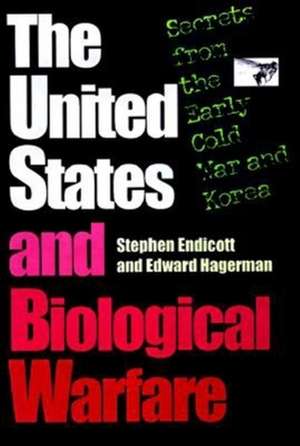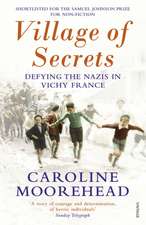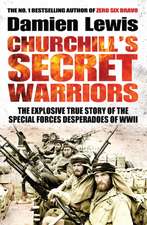The United States and Biological Warfare – Secrets from the Early Cold War and Korea
Autor Stephen Endicott, Edward Hagermanen Limba Engleză Hardback – 21 noi 1998
Preț: 252.44 lei
Nou
Puncte Express: 379
Preț estimativ în valută:
48.32€ • 52.50$ • 40.61£
48.32€ • 52.50$ • 40.61£
Carte tipărită la comandă
Livrare economică 21 aprilie-05 mai
Preluare comenzi: 021 569.72.76
Specificații
ISBN-13: 9780253334725
ISBN-10: 0253334721
Pagini: 304
Ilustrații: 62 b&w photos
Dimensiuni: 162 x 241 x 24 mm
Greutate: 0.57 kg
Editura: MH – Indiana University Press
ISBN-10: 0253334721
Pagini: 304
Ilustrații: 62 b&w photos
Dimensiuni: 162 x 241 x 24 mm
Greutate: 0.57 kg
Editura: MH – Indiana University Press
Cuprins
List of maps, tables, photo credits
Introduction
Chapter 1. Aches and Fevers in China and Korea
Chapter 2. Second World War Origins
Chapter 3. The Japanese Connection
Chapter 4. The Secretary of Defense and Revival of a Program
Chapter 5. Research and Development 1945-1953
Chapter 6. Plans and Missions
Chapter 7. Korea: a limited war?
Chapter 8. Psychological Warfare and the 581st ARC Wing
Chapter 9. The CIA in the Korean War
Chapter 10. Insect Vectors in Occupied Japan: Unit 406
Chapter 11. The Flyers
Chapter 12. Conclusion
Bibliographic Notes
Appendices
Index
Introduction
Chapter 1. Aches and Fevers in China and Korea
Chapter 2. Second World War Origins
Chapter 3. The Japanese Connection
Chapter 4. The Secretary of Defense and Revival of a Program
Chapter 5. Research and Development 1945-1953
Chapter 6. Plans and Missions
Chapter 7. Korea: a limited war?
Chapter 8. Psychological Warfare and the 581st ARC Wing
Chapter 9. The CIA in the Korean War
Chapter 10. Insect Vectors in Occupied Japan: Unit 406
Chapter 11. The Flyers
Chapter 12. Conclusion
Bibliographic Notes
Appendices
Index
Recenzii
This fascinating and deeply researched book examines whether the US used biological weapons when it attacked Korea. . . It shows that the US government, in collaboration with the British and Canadian governments, spent £800,000,000 between 1951 and 1953 developing such weapons, based on those used by the Japanese army in its attack on China. . . .The authors examine the evidence of germ-bearing insects, feathers and other carriers found after USAF bombing raids and look at the consequent outbreaks of unusual illnesses. . . The authors write, we are led to the conclusion that the United States took the final step and secretly experimented with biological weapons in the Korean War. Read the book and decide for yourself.Will Podmore, Morning Star, 9 August 1999
Notă biografică
Stephen Endicott was born in Shanghai of missionary parents and grew up in China before the Communist revolution. His family lived in Sichuan province for three generations where he returned to teach in the 1980s. Dr. Endicott, who is a graduate of the University of Toronto, has received the Killam Senior Fellowship and other academic awards while teaching East Asian history at York University. His books include Diplomacy and Enterprise: British China Policy 1933-1937, James G. Endicott: Rebel Out of China, and Red Earth: Revolution in a Sichuan Village.Edward Hagerman is a member of the history faculty of York University in Toronto. He has published many articles on the origins of modern war and modern total war, and has contributed to textbooks for the U.S. Military Academy at West Point, the U.S. Army Command and General Staff college, the U.S. Air Force Academy, and the Air War College of the U.S. Air Force. He has authored The American Civil War and the Origins of Modern Warfare.
Descriere
The authors reveal how the United States, with the help of Japanese war criminals, developed biological weapons and tested them on North Korean and Chinese civilians during the Korean War. 62 photos. 7 maps.










